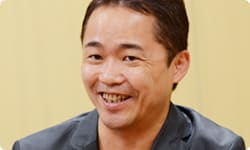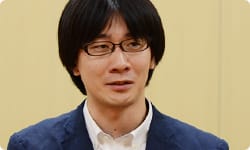How To Get The Rhythm Right
If you just take a glance at this game, you'll think it's just a sideways-scrolling platformer, but the boss battles actually feature a different kind of gameplay.
Yes, the boss battles were another element that added variety to the game.
How do these boss battles differ most strikingly from normal gameplay?
The gameplay usually entails striking enemies rhythmically as they appear, bang-bang-bang...
You keep going forward, using individual buttons to jump and strike enemies, don't you?
That's right, but during development the boss battles were known as the 'Rhythm Copy Mode'. It's a mode where the enemy attacks you in a certain rhythm, and you have to respond with counter attacks in exactly the same rhythm in order to defeat the enemy. This means that while the controls are extremely simple, the player will need very precise timing to match their rhythm with the sound and images.
The camera movements are also very dynamic.
The camera suddenly switches from a side view to a 3D perspective, and the nature of the gameplay shifts dramatically.
We were able to do that precisely because we had made the game controls so simple. If the controls had been tricky, and we had made it so the camera angle switched in this dynamic manner, a lot of players would have definitely found it too difficult.
Ah, yes. You're absolutely right. If you had the camera angle switching like this when you were running round a 3D area, you would end up losing track of which way you were facing.
That's right. But in this game, the player can focus on listening to the rhythm and pressing the buttons.
It feels to the player that they are doing amazing things simply by pressing the buttons.
That's something that grew out of the original plan I came up with. The idea was to have simple controls, while still giving the player a sense of being involved in an exciting adventure, and so we have these striking battle scenes that players will really enjoy.
With video game bosses, you might have an image of something that's incredibly strong, but in this game, there's a slight sense that you're getting let off a little lightly... (laughs)
Yes, that's really true! (laughs)
Maybe that's because the timing of the boss stages makes them feel a little like bonus stages.
Right.
But they are really exciting, aren't they?
Yes, they are. The graphics have a real energy.
The boss battles have a symphonic soundtrack, but you still have to stay in sync with the rhythm. I think we made rather unreasonable demands of the member of the team responsible for the audio, but in the end we succeeded in making it easy for the player to understand what they have to do.
There was a long process of trial and error before we successfully combined the music, dynamic graphics, and a well-balanced difficulty level.
Normally, the music in a game has nothing to do with the difficulty level, does it? (laughs)
Yes, that's true! (laughs)
But with this title, they are directly related, aren't they? It's not an exaggeration to say that the difficulty level is closely related to the music.
That's why the member of the team responsible for the audio was reduced to tears on a fair few occasions! (laughs)
Ah, yes. I can well imagine this project being really demanding for the person in charge of the audio.
Absolutely. Towards the end, we worked on the symphonic boss battles and getting the difficulty level of these stages right proved incredibly challenging. We made countless adjustments to the rhythm of the game, as well as the number of times you needed to press the buttons.
And I'd imagine that if you didn't stick to the rhythm, so to speak, Masuda-san would be there right away to check what you were doing. (laughs)
Right, and those checks were really strict! (laughs)
(laughs)
Well Masuda-san originally comes from an audio background, and came up with all the music for the first generation of Pokémon titles4, so naturally he is highly attuned to issues related to this side of things. I'd imagine he had plenty to say on this score. 4. First generation of Pokémon titles: This refers to Pokémon Red and Green, role-playing games released in Japan for Game Boy in February 1996.
Minako Adachi5 was in charge of the audio content and in general, we could entrust everything to her. But for the sections where the rhythm was particularly difficult, I gave her a fair bit of advice. Then when I played the game in the debug phase, there were times when I got the feeling that the game was really not in sync with my own sense of rhythm. 5. Minako Adachi: A musician and composer who works for GAME FREAK inc.
Ah, yes. There were, weren't there? (laughs)
I told a member of the team that there was something off about a particular section, but they said they couldn't hear anything wrong with it. Then when we investigated it, we found that the images were indeed out of sync with the rhythm by a few frames.
Ha! Well, we'd expect nothing less! (laughs) I'd imagine you felt really happy when you spotted issues like that, right?
Yes, I was. There are few things I love more! (laughs)
(laughs)
We also did a lot of fine-tuning to other things, such as the motion of the attacks.
If the movement of the player character is even a couple of frames out of sync, the impression the player gets will change significantly. There haven't really been that many platform games where the rhythm and action have been so integrally linked.
Yes, you're right. Naturally, regular rhythm games would have a lot of attention paid to the timing, but there aren't that many precedents for rhythm games like this, with such strong elements of a platformer.
In rhythm games, there's generally some kind of on-screen marker...
Yes, then you try to get the timing right and press the button at that moment indicated by the marker.
In this game, there are no markers. Or rather, the marker is the player character himself. When he collides with an enemy, he takes damage, so you need to press a button before that happens. But it took us a really long time to decide precisely how to time that right, and we had to play the game a lot to really get a feel for how we would have to adjust things.
Because of the nature of the game, I'd imagine that you had to pay a great deal of attention to the motion of both the player character and the enemies.
Right. So for instance, even with motions like running, with a normal player character, it's enough to have a natural running motion. But with a game like this, we had to make him run in a rhythmical manner. Then on stages with faster tempos... well, he runs like this... (moves head up and down)
When you see that, it becomes really easy to get a sense of the rhythm.
We've also made it so the staff the player character is holding flashes in time to the beat...
The hearts indicating HP at the bottom of the screen also move in time to the beat.
So this means that there are all sorts of indicators of what the right rhythm should be embedded in the on-screen display.
Yes, that's right, and I think this has led to a really nice sense of the graphics and audio being integrally linked.



